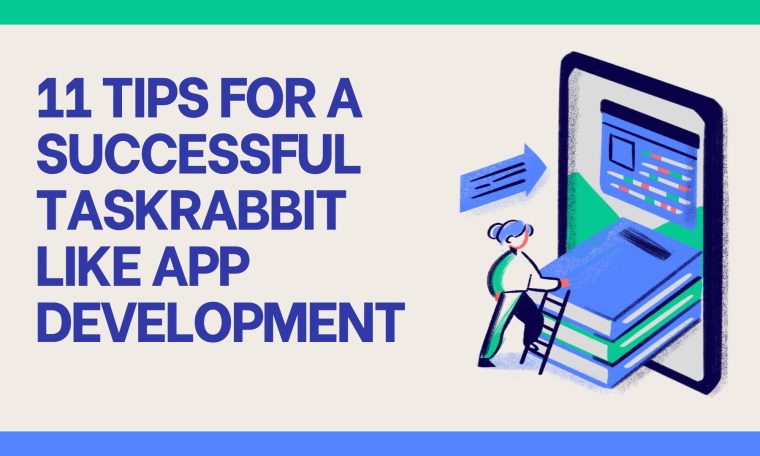
The gig economy has transformed how many service-based tasks get accomplished through on-demand platforms. TaskRabbit, one of the pioneering players in this space, has connected millions of ‘Taskers’ with people needing quick help at home or work since 2008.
This unprecedented success stems not only from timing the sharing economy wave, but also nailing key product and business fundamentals. Now entrepreneurs are looking to recreate similar marketplaces in alternative categories or new regions.
In this article, we will cover 11 essential tips distilled from TaskRabbit like app to develop a thriving on-demand task platform app of your own from the ground up.
Tip 1: Choose the Right Technology Stack
Selecting high-performance, scalable frameworks future-proofs your MVP and ability to handle big traffic once viral. React Native is a great cross-platform choice for its native-app speed paired with web development efficiency.
Other proven combinations are Ionic/Cordova with Angular/React on the frontend. Django/Flask with PostgreSQL make full-stack web apps robust. Consider AWS, Heroku or Firebase for backend hosting.
Well-optimized native iOS/Android code also works but needs dedicated mobile teams. Early stability favors proven tech over bleeding-edge tools. Scaled foundations minimize technical debt down the line. To learn more: https://zipprr.com/taskrabbit-clone/
Tip 2: Focus on the User Experience
Blazing task posting/bidding speed and flawless workflow navigation create delighted early users. Mimic fast food kiosks – keep friction ultra-low.
Mobile-first UX should glean key details with minimal taps. Well-designed search/filters allow finding the perfect provider within seconds. Intuitive scheduling completes the hiring process online.
Always test usability assumptions – users rarely behave as expected. Iterative development informed by qualitative feedback yields an enjoyable experience propelling growth. Great UX triumphs over any feature.
Tip 3: Build a Large Task Catalog
Covering popular errands, chores, delivery tasks gets the flywheel spinning fast. But also include skills like assembly, tutorials, repair classes to creatively solve niche problems.
New categories emerge through analytics/user suggestions, so plan an open-ended schema. Enable submit able task templates standardizing reoccurring jobs. This variety casts a wide user net.
Contextualize tasks by location/industry for discovery. But standardized naming/descriptions across niches boosts proficiency over time via machine learning. Consistency maximizes matches.
Tip 4: Optimize the Bidding Process
Quick, succinct proposals accelerate matches without overwhelming users. Recommend top providers to the posting user based on ratings, distance, jobs completed successfully before.
Profile previews let hirers grasp providers’ service quality commitment. Standardized pricing policies prevent undercutting. But allow negotiated additions if special materials/skills are required.
Gamify it by showing proposal count/response times to gently nudge users. Statistics assure both buyers and providers of busy market activity, building trust in the platform. Scalable matching is key.
Tip 5: Integrate Robust Payments
Plan payment flows proactively factoring compliance. Support local wallets, bank transfers alongside credit cards globally. Offline cash remains popular too for trust.
Enable project-wise payment scheduling upon completion, with holds for disputes. Consider upfront booking deposits too as is standard. Facilitate micro-payments under $10 effectively through payment processors.
Collect honest user feedback through incentivized surveys on experience. Data powers better risk-assessment, fraud detection and funds security over time through ML. Payments legitimize the work.
Tip 6: Develop Mobile-First TaskRabbit Like App
Over 75% users access on-demand platforms via phones today. Design assuming all traffic originates here from the start. Progressive Web Apps bypass app stores too while being high-performant like native.
Prioritize core tasks/hiring flows in small screens. Provide separate dashboard/admin interfaces for larger displays but don’t compromise mobile. Tailor copy, inputs and visual elements for thumbs.
Location services, photos and SMS/calling integrations supercharge discovery and make it seamless to reach out. Mobile unlocks geo-based relevance central to local hiring.
Tip 7: Leverage Location Services
Geotag listings based on address/GPS to foster trust between nearby users transacting physically. Highlight descriptors like postal codes for easy identification in TaskRabbit like app.
Proposed task deadline times should factor commuting. Allow adjusting provider location/service radius for demand flexibility. Reputation showcases local market expertise to regular area clients.
Recommend providers consistently based on recent completed jobs and proximity. Pushing activity happening closest nurtures community bonds strengthening the local marketplace.
Tip 8: Facilitate Reviews & Ratings
Publicly showcasing multidimensional feedback establishes clear performance baselines incentivizing quality work. Standardized ratings factor timely delivery, communication, work standards on Likert scales.
Filtering search results by top-rated providers reassures users. Quality providers appreciate such social proofs helping their jobs too. Anonymous review systems prevent retaliation.
Automatically send rating requests post-task helps capture honest sentiment while fresh. But allow modifying reviews if feedback was misdirected. Transparent systems build trust at scale.
Tip 9: Launch Effective Marketing in TaskRabbit Like App
Promote through relevant communities, job sites and local listing partners. Contact college hire boards and youth organizations promoting skill-learning through useful work.
Run targeted Facebook/Google ad campaigns optimizing spend against conversion actions like signup. Leverage influencer partnerships and affiliate programs strategically.
An initial high user incentive like welcome credits or price discounts gets trial sticky. Grow organically thereafter emphasizing benefits in locally-focused marketing copy and imagery appealing to values like income flexibility.
Tip 10: Expand to New Markets Gradually
Test complex features in a single city first before country/region rollout. This catches unforeseen user behavior or technology gaps.
Hire localized staff for customer support before launch. Train community managers fluent in cultural nuances promoting harm prevention guidelines sensitively.
Partner experienced local entrepreneurs as trusted advisors providing community references. Translate content gradually based on traction, not prematurely. Controlled scaling avoids chaos from over-commitments.
Tip 11: Continuously Improve with Feedback
Always prioritize high-value improvements based on analytics and qualitative inputs. Add missing tasks to maximize addressable problems.
Streamline onboarding flows through constant A/B testing. Roll out safety guardrails informed by incident reviews. Build advanced search and automated reminders.
Community feedback programs foster ownership over requested changes. Reward top reviewers and quickly solve issues reported. Nurture brand evangelism through community programs. An evolving platform retains users long-term.
Conclusion
The on-demand app development economy is here to stay transforming how we consume services conveniently. By keeping users’ shifting needs and localized nuances center stage every step, task platforms like TaskRabbit achieve global scale. With disciplined focus on the above fundamentals during development and beyond, entrepreneurs can replicate such career- and income-generating success through community-powered sharing economy solutions tailored to their market. The opportunities are immense for those dedicated to solving user problems creatively at a hyperlocal level.



